AP Unit 6: Developmental Psychology (Myers Unit 9) (copy)
1/95
Earn XP
Description and Tags
Myers Unit 9: Developmental Psychology
Name | Mastery | Learn | Test | Matching | Spaced |
|---|
No study sessions yet.
96 Terms
Developmental Psychology
a branch of psychology that studies physical, cognitive, and social change throughout the life span.
Nature vs. Nurture
the interaction between our genetic inheritance and our experiences
Stage vs. Continuity
which aspects of development are gradual and continuous, and which change relatively abruptly
Stability vs. Change
whether our traits endure or change as we age
Germinal Stage
period of prenatal development from fertilization to the end of the second week (14 days). Includes rapid cell division, implantation in the uterus, and formation of the placenta.
Stages of Prenatal Development
Germinal Stage (first 2 weeks after conception): rapid cell division and implantation in the uterus.
Embryonic Stage (weeks 3-8): major organs and body systems develop, embryo vulnerable to external factors.
Critical Period: Specific times when organs and systems are most susceptible to damage or development.
Teratogens: Substances or factors that can cause birth defects or developmental abnormalities.
Fetal Stage (9 weeks-birth): rapid growth, refinement of organs, and development of senses.

zygote
the fertilized egg; it enters a 2-week period of rapid cell division and develops into an embryo.
embryo
the developing human organism from about 2 weeks after fertilization through the second month.
fetus
the developing human organism from 9 weeks after conception to birth.
teratogens
(literally, “monster makers”) agents, such as chemicals and viruses, that can reach the embryo or fetus during prenatal development and cause harm.
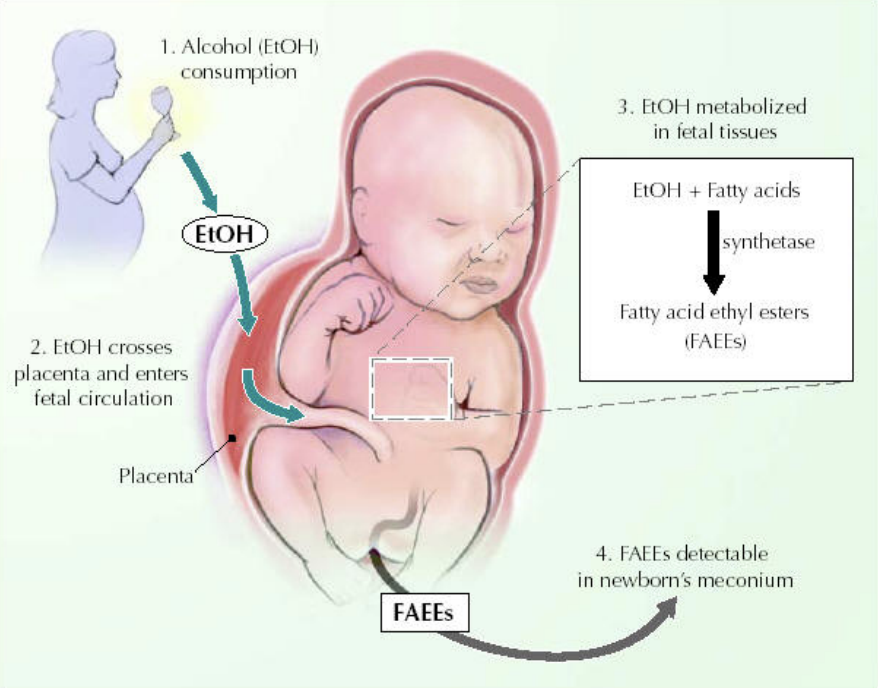
Fetal alcohol syndrome
physical and cognitive abnormalities in children caused by a pregnant woman’s heavy drinking. In severe cases, signs include a small, out-of-proportion head and abnormal facial features.
habituation
decreasing responsiveness with repeated stimulation. As infants gain familiarity with repeated exposure to a stimulus, their interest wanes and they look away sooner.
maturation
biological growth processes that enable orderly changes in behavior, relatively uninfluenced by experience.
cognition
all the mental activities associated with thinking, knowing, remembering, and communicating.
schema
a concept or framework that organizes and interprets information.
assimilation
interpreting our new experiences in terms of our existing schemas.
accommodation
adapting our current understandings (schemas) to incorporate new information.
Piaget’s Theory of Cognitive Development
Piaget believed that children construct their understanding of the world while interacting with it. Their minds experience spurts of change, followed by greater stability as they move from one cognitive plateau to the next, each with distinctive characteristics that permit specific kinds of thinking. In Piaget’s view, cognitive development consisted of four major stages—sensorimotor, preoperational, concrete operational, and formal operational.
Age Range | Stages | Key Milestones |
|---|---|---|
Birth to nearly 2 years | Sensorimotor Experiencing the world through senses and actions (looking, hearing, touching, mouthing, and grasping) |
|
About 2 to 6 or 7 years | Preoperational Representing things with words and images; using intuitive rather than logical reasoning |
|
About 7 to 11 years | Concrete operational Thinking logically about concrete events; grasping concrete analogies and performing arithmetical operations |
|
About 12 through adulthood | Formal operational Reasoning abstractly |
|
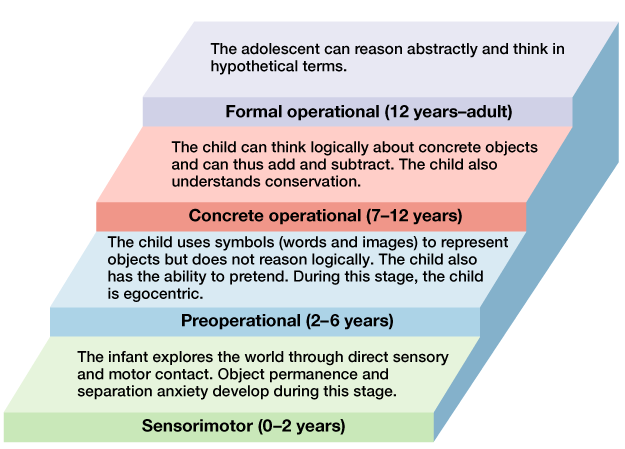
Sensorimotor stage
in Piaget’s theory, the stage (from birth to nearly 2 years of age) during which infants know the world mostly in terms of their sensory impressions and motor activities.
Object permanence
the awareness that things continue to exist even when not perceived.
Preoperational stage
in Piaget’s theory, the stage (from about 2 to 6 or 7 years of age) during which a child learns to use language but does not yet comprehend the mental operations of concrete logic.
conservation
the principle (which Piaget believed to be a part of concrete operational reasoning) that properties such as mass, volume, and number remain the same despite changes in the forms of objects.
egocentrism
in Piaget’s theory, the preoperational child’s difficulty taking another’s point of view.
Theory of mind
people’s ideas about their own and others’ mental states—about their feelings, perceptions, and thoughts, and the behaviors these might predict.
Concrete operational stage
in Piaget’s theory, the stage of cognitive development (from about 7 to 11 years of age) during which children gain the mental operations that enable them to think logically about concrete events.
Formal operational stage
in Piaget’s theory, the stage of cognitive development (normally beginning about age 12) during which people begin to think logically about abstract concepts.
Vygotsky’s Theory of Development
Lev Vygotsky’s studies of child development focused on the ways a child’s mind grows by interacting with the social environment. In his view, parents and caretakers provide what we now call temporary scaffolds enabling children to step to higher levels of learning.
scaffold
a framework that offers children temporary support as they develop higher levels of thinking.
Zone of proximal development
The range between what a child can do independently and what they can achieve with guidance and support.

Autism spectrum disorder (ASD)
a disorder that appears in childhood and is marked by significant deficiencies in communication and social interaction, and by rigidly fixated interests and repetitive behaviors.
Ainsworth’s Strange Situation
a procedure for studying child-caregiver attachment; a child is placed in an unfamiliar environment while their caregiver leaves and then returns, and the child’s reactions are observed.
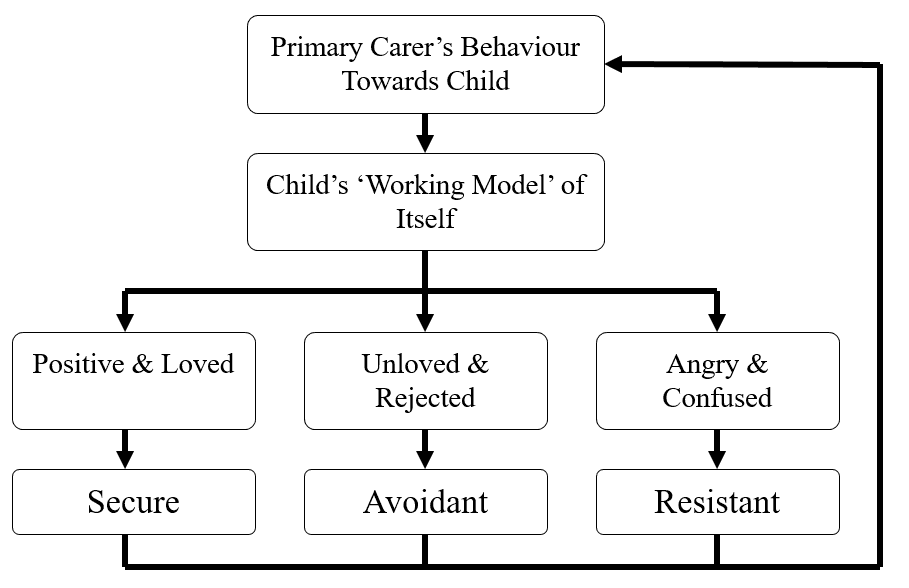
Stranger anxiety
the fear of strangers that infants commonly display, beginning by about 8 months of age.
attachment
an emotional tie with another person; shown in young children by their seeking closeness to their caregiver and showing distress on separation.
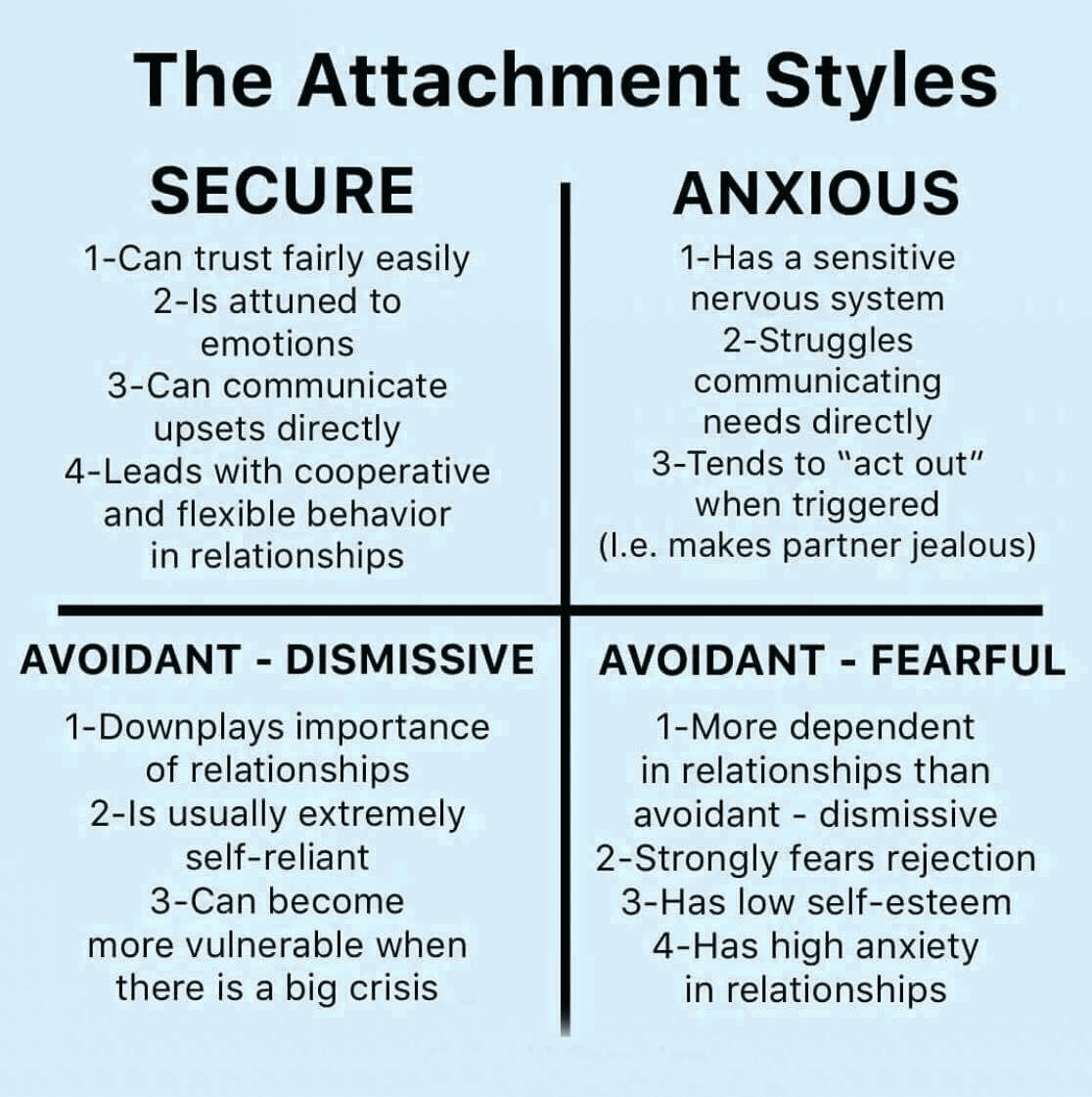
Critical period
an optimal period early in the life of an organism when exposure to certain stimuli or experiences produces normal development.
imprinting
the process by which certain animals form strong attachments during early life.
Secure attachment
demonstrated by infants who comfortably explore environments in the presence of their caregiver, show only temporary distress when the caregiver leaves, and find comfort in the caregiver’s return.
Will explore the unfamiliar room
Subdued when mother left and greeted her positively when she returned
Moderate avoidance of the stranger, but friendly when mother present
Mothers were described as sensitive
Insecure Avoidant attachment
demonstrated by infants who display an avoidant attachment that resists closeness.
Do not orientate to their mother while investigating the room and toys and do not seem concerned by her absence.
Showed little interest when mother returned
Avoided the stranger, but not as strongly as they avoided the mother on her return
Mothers sometimes ignored their infants
Insecure resistant or ambivalent attachment
demonstrated by infants who display either a clinging, anxious attachment or an avoidant attachment that resists closeness.
Show intense distress, particularly when their mother was absent but rejected mother when she returned
Showed ambivalent (opposites) behavior towards the stranger, similar to the pattern of resistance and interest shown with their mother
Mothers appeared to behave ambivalently towards their infants.
Disorganized or Fearful-avoidant attachment
demonstrated by infants who exhibit unpredictable behaviors, characterized by inconsistent behavior in the presence of a caregiver.
Displaying a lack of clear attachment behavior towards their caregiver.
Showing fear, confusion, or avoidance of the caregiver when they approach or attempt to comfort them.
Demonstrating disorganized and contradictory behaviors, such as freezing, rocking, or appearing dazed.
Displaying difficulty in regulating their emotions and behaviors in stressful situations.
Exhibiting a lack of a consistent pattern of seeking proximity to the caregiver or exploring the environment.
temperament
a person’s characteristic emotional reactivity and intensity.
Psycho-Sexual Stages of Development
the childhood stages of development (oral, anal, phallic, latency, genital) during which, according to Freud, the id’s pleasure-seeking energies focus on distinct erogenous zones.
Stage | Focus |
|---|---|
Oral (0–18 months) | Pleasure centers on the mouth—sucking, biting, chewing |
Anal (18–36 months) | Pleasure focuses on bowel and bladder elimination; coping with demands for control |
Phallic (3–6 years) | Pleasure zone is the genitals; coping with incestuous sexual feelings |
Latency (6 to puberty) | A phase of dormant sexual feelings |
Genital (puberty on) | Maturation of sexual interests |
Basic trust
according to Erik Erikson, a sense that the world is predictable and trustworthy; said to be formed during infancy by appropriate experiences with responsive caregivers.
self-concept
all our thoughts and feelings about ourselves in answer to the question, “Who am I?”
sex
in psychology, the biologically influenced characteristics by which people define male and female.
gender
in psychology, the socially influenced characteristics by which people define boy, girl, man, and woman.
aggression
any physical or verbal behavior intended to harm someone physically or emotionally.
Relational aggression
an act of aggression (physical or verbal) intended to harm a person’s relationship or social standing.
role
a set of expectations (norms) about a social position, defining how those in the position ought to behave.
Gender role
a set of expected behaviors, attitudes, and traits for males or for females.
Gender identity
our sense of being male, female, or some combination of the two.
Social learning theory
the theory that we learn social behavior by observing and imitating and by being rewarded or punished.
Gender typing
the acquisition of a traditional masculine or feminine role
androgyny
displaying both traditional masculine and feminine psychological characteristics.
transgender
an umbrella term describing people whose gender identity or expression differs from that associated with their birth-designated sex.
adolescence
the transition period from childhood to adulthood, extending from puberty to independence.
puberty
the period of sexual maturation, during which a person becomes capable of reproducing.
Erikson’s 8 Psychosocial Stages
Identity Stage (approximate age) | Issues | Description of Task |
|---|---|---|
Infancy (to 1 year) | Trust vs. mistrust | If needs are dependably met, infants develop a sense of basic trust. |
Toddlerhood (1 to 2 years) | Autonomy vs. shame and doubt | Toddlers learn to exercise will and do things for themselves, or they doubt their abilities. |
Preschooler (3 to 5 years) | Initiative vs. guilt | Preschoolers learn to initiate tasks and carry out plans, or they feel guilty about efforts to be independent. |
Elementary school (6 years to puberty) | Competence vs. inferiority | Children learn the pleasure of applying themselves to tasks, or they feel inferior. |
Adolescence (teen years into 20s) | Identity vs. role confusion | Teenagers work at refining a sense of self by testing roles and then integrating them to form a single identity, or they become confused about who they are. |
Young adulthood (20s to early 40s) | Intimacy vs. isolation | Young adults struggle to form close relationships and to gain the capacity for intimate love, or they feel socially isolated. |
Middle adulthood (40s to 60s) | Generativity vs. stagnation | The middle-aged discover a sense of contributing to the world, usually through family and work, or they may feel a lack of purpose. |
Late adulthood (late 60s and up) | Integrity vs. despair | When reflecting on his or her life, the older adult may feel a sense of satisfaction or failure. |

Kohlberg’s theory of moral development
Level | Focus | Example |
|---|---|---|
Preconventional morality (before age 9) | Self-interest; obey rules to avoid punishment or gain concrete rewards. | “If you save your dying wife, you’ll be a hero.” |
Conventional morality (early adolescence) | Uphold laws and rules to gain social approval or maintain social order. | “If you steal the drug for her, everyone will think you’re a criminal.” |
Postconventional morality (adolescence and beyond) | Actions reflect belief in basic rights and self-defined ethical principles. | “People have a right to live.” |
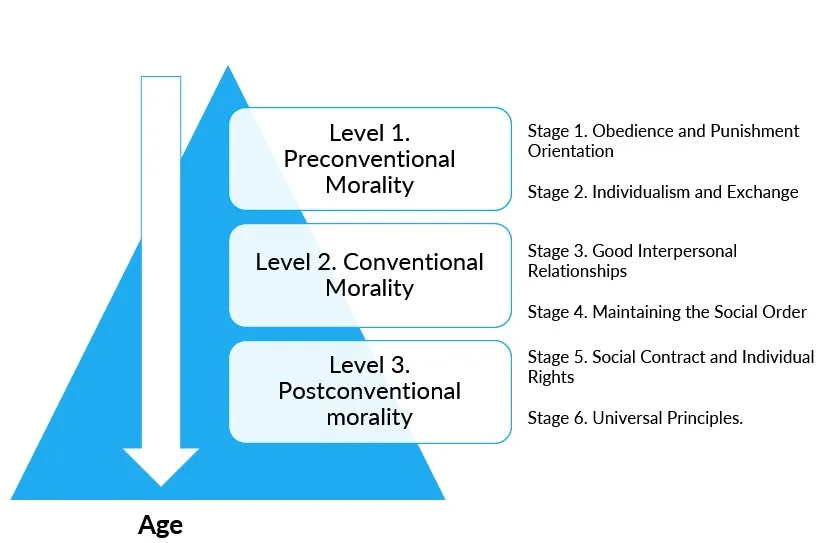
Preconventional Morality
Self-interest; obey rules to avoid punishment or gain concrete rewards.
Conventional Morality
Uphold laws and rules to gain social approval or maintain social order.
Postconventional Morality
Actions reflect belief in basic rights and selfdefined ethical principles.
Parenting Styles (Authoritative, authoritarian, permissive, uninvolved/negligent)
Authoritative: A parenting style that is both demanding and responsive. Parents set clear rules and expectations while also being supportive and nurturing and encouraging independence. Authoritative parents are confrontive. They are both demanding and responsive. They exert control by setting rules, but, especially with older children, they encourage open discussion and allow exceptions.
Example: Mrs. Weasley from Harry Potter.
Authoritarian: A parenting style that is highly demanding but lacks warmth and responsiveness. Parents have high expectations, little flexibility, and enforce strict rules without considering the child's needs. Authoritarian parents are coercive. They impose rules and expect obedience: “Don’t interrupt.” “Keep your room clean.” “Don’t stay out late or you’ll be grounded.” “Why? Because I said so.”
Example: Miss Trunchbull from Matilda.
Permissive: A parenting style that is low in demands and high in responsiveness. Parents have few rules or boundaries and allow their children to do as they please. Permissive parents are unrestraining and laid-back. They make few demands, set few limits, and use little punishment.
Example: Regina George’s Mom from Mean Girls.
She’s not a “regular mom,” she’s a “cool mom.”
Uninvolved/Negligent: A parenting style where parents are neither demanding nor responsive. They are emotionally and physically detached and show little interest or involvement in their children's lives. Negligent parents are uninvolved. They are neither demanding nor responsive. They are careless, inattentive, and do not seek to have a close relationship with their children.
Example: Ben Gross from Never Have I Ever.

identity
our sense of self; according to Erikson, the adolescent’s task is to solidify a sense of self by testing and integrating various roles.
Social identity
the “we” aspect of our self-concept; the part of our answer to “Who am I?” that comes from our group memberships.
intimacy
in Erikson’s theory, the ability to form close, loving relationships; a primary developmental task in young adulthood.
Emerging adulthood
a period from about age 18 to the midtwenties, when many in Western cultures are no longer adolescents but have not yet achieved full independence as adults.
X Chromosome
the sex chromosome found in both males and females. Females typically have two X chromosomes; males typically have one. An X chromosome from each parent produces a female child.
Y Chromosome
the sex chromosome typically found only in males. When paired with an X chromosome from the mother, it produces a male child.
testosterone
the most important male sex hormone. Both males and females have it, but the additional testosterone in males stimulates the growth of the male sex organs during the fetal period, and the development of the male sex characteristics during puberty.
Primary sex characteristics
the body structures (ovaries, testes, and external genitalia) that make sexual reproduction possible.
Secondary sex characteristics
nonreproductive sexual traits, such as female breasts and hips, male voice quality, and body hair
spermarche
the first ejaculation.
menarche
the first menstrual period.
intersex
a condition present at birth due to unusual combinations of male and female chromosomes, hormones, and anatomy; possessing biological sexual characteristics of both sexes.
AIDS
a life-threatening, sexually transmitted infection caused by the human immunodeficiency virus (HIV). AIDS depletes the immune system, leaving the person vulnerable to infections.
Sexual orientation
our enduring sexual attraction, usually toward members of our own sex (homosexual orientation) or the other sex (heterosexual orientation); variations include attraction toward both sexes (bisexual orientation).
attraction
the emotional and cognitive processes that draw individuals towards one another. It encompasses the desire for social interaction, forming relationships, and experiencing a sense of closeness. Attraction can be influenced by factors such as physical appearance, similarity, proximity, and shared interests.
menopause
the time of natural cessation of menstruation; also refers to the biological changes a woman experiences as her ability to reproduce declines.
Cross-sectional study
research that compares people of different ages at the same point in time.
Longitudinal study
research that follows and retests the same people over time.
Neurocognitive disorders (NCDs)
acquired (not lifelong) disorders marked by cognitive deficits; often related to Alzheimer’s disease, brain injury or disease, or substance abuse. In older adults, neurocognitive disorders were formerly called dementia.
Alzheimer’s disease
a neurocognitive disorder marked by neural plaques, often with onset after age 80, and entailing a progressive decline in memory and other cognitive abilities.
Social clock
the culturally preferred timing of social events such as marriage, parenthood, and retirement.
Biological clock
helps regulate and control the timing of bodily processes, including circadian rhythms
Sigmund Freud
Austrian neurologist and the founder of psychoanalysis. He proposed the psychosexual stages of development, including oral, anal, phallic, latency, and genital stages. Believed that childhood experiences and unconscious desires shape personality development. His theories sparked controversy but significantly influenced the field of psychology, particularly in understanding the role of unconscious processes in human behavior.
Jean Piaget
Swiss psychologist known for his theory of cognitive development. Proposed that children's thinking evolves through four stages: sensorimotor, preoperational, concrete operational, and formal operational. He emphasized the importance of active exploration and interaction with the environment in learning and development.
Lev Vygotsky
Russian psychologist known for sociocultural theory. Emphasized role of social interactions in cognitive development. His work influenced education and child development.
Harry Harlow
American psychologist known for his research on maternal deprivation and attachment in rhesus monkeys. His experiments showed that infant monkeys preferred a soft, cloth surrogate mother over a wire one with food, emphasizing the importance of contact comfort in forming emotional bonds.
Margaret Harlow
Known for her research on attachment and the importance of social relationships in child development. She conducted the "Harlow's Monkeys" experiment, which demonstrated the significance of maternal love and touch in shaping emotional well-being.
Konrad Lorenz
Austrian zoologist and ethologist known for his work on imprinting in animals. Studied animal behavior and imprinting, focusing on how animals develop and interact with their environment. Studied the behavior of goslings and observed their attachment to the first moving object they saw after hatching. Proposed the concept of critical periods in development. Pioneered the field of ethology, which studies animal behavior in natural environments.
Mary Ainsworth
Researcher known for the “Strange Situation” experiment, which assessed attachment styles in infants. Identified secure, insecure-avoidant, insecure-resistant, and insecure disorganized-fearful attachment patterns.
Erik Erikson
Psychologist known for the theory of psychosocial development. Believed individuals go through 8 stages, each with a unique crisis to resolve.
Diana Baumrind
Developmental psychologist known for proposing the theory of parenting styles. She identified four main styles: authoritarian (strict and controlling), authoritative (supportive and nurturing), permissive (lax and indulgent), and negligent (uninvolved and inattentive). Her research emphasized the importance of parenting in child development and its impact on behavior and outcomes.
Carol Gilligan
Prominent psychologist in developmental psychology. Known for her work on gender differences and moral development. Criticized Kohlberg's theory for being biased towards males. Introduced the concept of the ethics of care, emphasizing relationships and empathy. Her research highlights the importance of considering gender in understanding human development.
Albert Bandura
Psychologist known for social learning theory. Emphasized the importance of observational learning and self-efficacy in development. Conducted the famous Bobo doll experiment to demonstrate how children imitate aggressive behavior. Proposed that individuals learn through observation, imitation, and reinforcement. Key figure in understanding the role of social influences on behavior.
Lawrence Kohlberg
Psychologist known for his theory of moral development. Believed individuals progress through 6 stages of moral reasoning, from obedience to universal ethical principles. Emphasized the importance of moral dilemmas in shaping moral thinking.